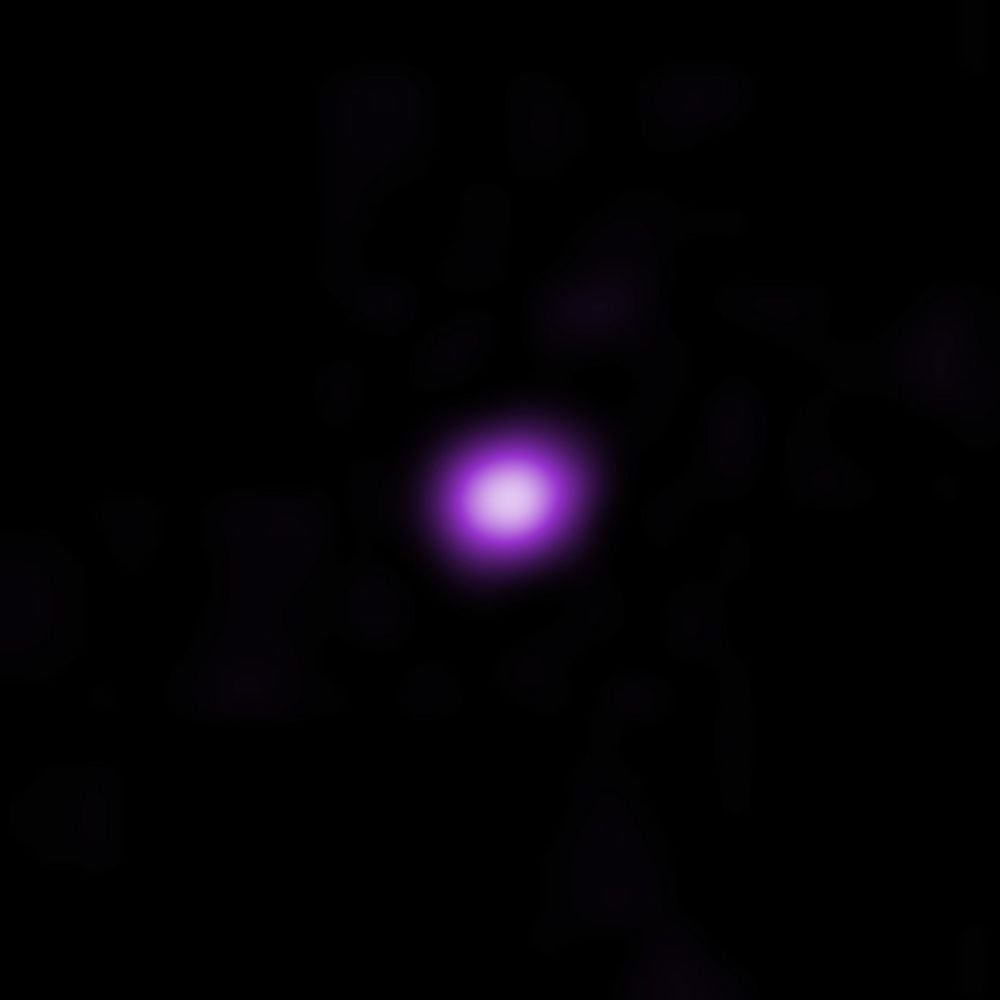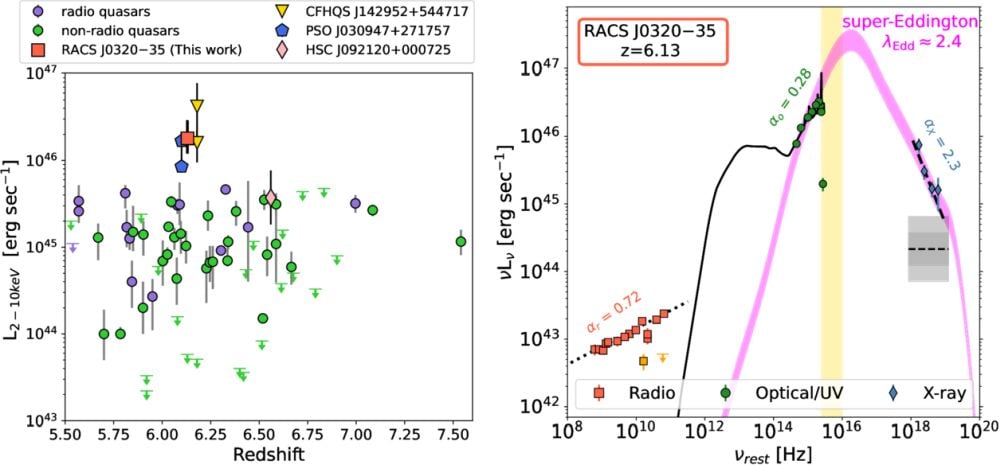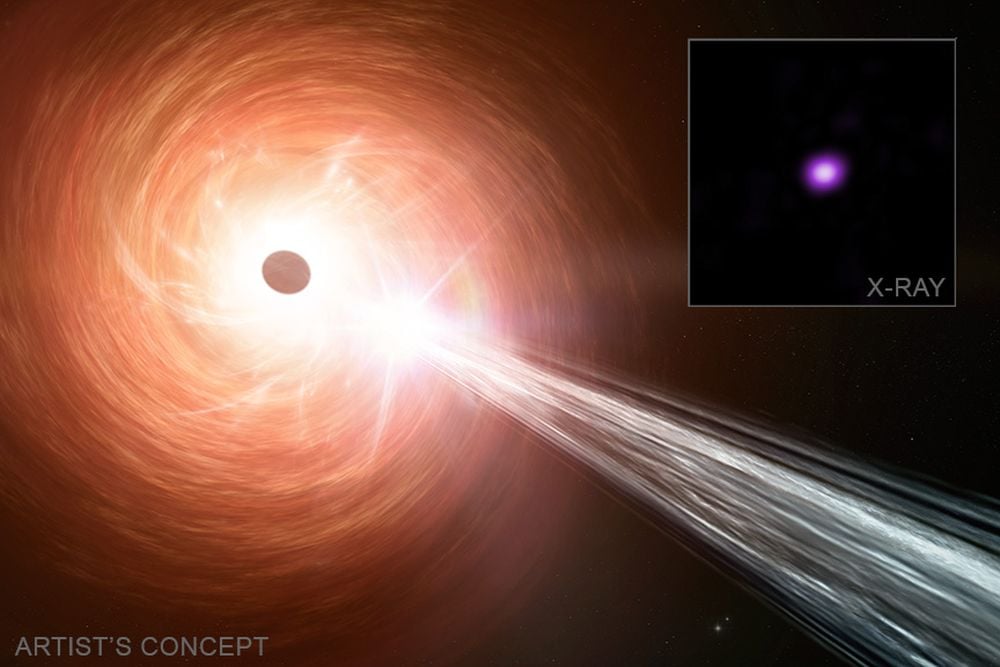One of the JWST’s most startling discoveries was that black holes were extremely massive in the early Universe, less than one billion years after the Big Bang. The discovery defied explanation, since astrophysicists thought that it would take much more time for black holes to accrete so much mass. An explanation for this discrepancy may lie in a massive black hole observed with NASA’s Chandra X-ray Observatory.
RACS J0320-35 is a quasar, an active galactic nucleus powered by a supermassive black hole in the heart of a galaxy. At z = 6.13, Chandra is seeing the quasar as it was when the Universe was only 950 million years old. Quasars are extremely luminous, and as they gather matter in their accretion disks, the matter heats up and emits x-rays. Some quasars can also have prominent x-ray jets of material shooting out of their poles.
Astronomers discovered RACS J0320-35 a couple of years ago, and it produces more x-rays than any other black hole seen at similar redshifts. It took a couple of years of determined observations, especially with Chandra, to figure out why it was x-ray bright.
New research in The Astrophysical Journal Letters presents the new observations of RACS J0320-35 and explains why it’s so luminous, and why it’s so massive so early in the Universe’s timeline. It’s titled “X-Ray Investigation of Possible Super-Eddington Accretion in a Radio-loud Quasar at z = 6.13,” and the lead author is Luca Ighina. Ighina is from the Harvard and Smithsonian Center for Astrophysics.
 RACS J0320-35 as seen in x-rays by NASA’s Chandra X-ray Observatory. Image Credit: X-ray: NASA/CXC/INAF-Brera/L. Ighina et al.; Illustration: NASA/CXC/SAO/M. Weiss; Image Processing: NASA/CXC/SAO/N. Wolk
RACS J0320-35 as seen in x-rays by NASA’s Chandra X-ray Observatory. Image Credit: X-ray: NASA/CXC/INAF-Brera/L. Ighina et al.; Illustration: NASA/CXC/SAO/M. Weiss; Image Processing: NASA/CXC/SAO/N. Wolk
“It was a bit shocking to see this black hole growing by leaps and bounds,” said lead author Ighina in a press release.
The key to the massive black hole mystery lies in the term “Super-Eddington Accretion.”
One of the fundamental concepts in astrophysics is the Eddington limit. It describes the maximum rate at which an astrophysical object like a black hole can accrete matter while maintaining stability. All luminous objects exert an outward pressure, and the Eddington limit is when that outward pressure is balanced against the object’s inward gravitational pull. If an object exceeds the Eddington limit, then it becomes unstable.
However, there’s also something called Super-Eddington Accretion. It’s a fundamental puzzle in astrophysics that allows objects to breach the Eddington limit. Super-Eddington Accretion is complex, but the basic idea is that accretion onto an object like a black hole isn’t symmetrical. In reality, material drawn to a black hole forms a torus, and astrophysicists think that condition inside the torus create powerful outflowing winds that blow gas away. But the outflows aren’t uniform, and the end result is that not all of the black hole’s radiation can escape. That means that the black hole’s outward pressure can’t halt the inflow of matter, and the inflow temporarily allows the black hole to exceed the Eddington Limit and experience Super-Eddington Accretion.
Black holes can emit relativistic jets, narrow beams of high-energy particles travelling at near the speed of light. These jets are visible in optical and radio, but also emit powerful x-rays. The question the researchers asked themselves is if RACS J0320-35’s extreme x-ray luminosity can be explained by jets, or is Super-Eddington Accretion responsible?
“By analyzing the overall spectral energy distribution of the quasar, we found that the remarkably soft X-ray emission (1) cannot be produced by relativistic jets, even when relativistic boosting is considered, and (2) is consistent with expectations for a super-Eddington accreting supermassive black hole,” the authors write in their research.
 This figure from the research illustrates how RACS J0320-35 stands out. The left panel shows luminosity as a function of redshift for the z > 5.5 quasars with X-ray observations from either Chandra or XMM-Newton. Several objects are highlighted, and the only one that may be more luminous is an extremely X-ray luminous radio-loud quasar named CFHQS J142952+544717. The right panel shows the rest-frame, multiwavelength SED of RACS J0320−35 in radio, optical-UV, and x-ray. The black line represents a quasar template matched to the optical-UV data points. The magenta line shows what the X-ray-weak super-Eddington Spectral Energy Distribution would look like. “As is clear from the plot, RACS J0320−35 is among the X-ray-brightest sources in this redshift range,” the authors write. Image Credit: Ighina et al. 2025. ApJL
This figure from the research illustrates how RACS J0320-35 stands out. The left panel shows luminosity as a function of redshift for the z > 5.5 quasars with X-ray observations from either Chandra or XMM-Newton. Several objects are highlighted, and the only one that may be more luminous is an extremely X-ray luminous radio-loud quasar named CFHQS J142952+544717. The right panel shows the rest-frame, multiwavelength SED of RACS J0320−35 in radio, optical-UV, and x-ray. The black line represents a quasar template matched to the optical-UV data points. The magenta line shows what the X-ray-weak super-Eddington Spectral Energy Distribution would look like. “As is clear from the plot, RACS J0320−35 is among the X-ray-brightest sources in this redshift range,” the authors write. Image Credit: Ighina et al. 2025. ApJL
If Super-Eddington Accretion is responsible, then how big was the black hole when it first formed, how quickly is it accreting mass, and for how long has it been doing that? Answers to those questions can explain why the JWST found such massive black holes so soon after the Big Bang.
For a black hole to have one billion solar masses only one billion years after the Big Bang, it means one of two things must have happened. The first it that it could have formed with about 10,000 solar masses. A black hole that massive couldn’t have formed from stellar collapse. Instead, it must have formed in an exotic process where a massive, dense gas cloud with very low metallicity collapsed all at once. However, these conditions are thought to be extremely rare.
The other option is that the black hole is experiencing Super-Eddington accretion. If this is the case, then the black hole could have formed when a massive star collapsed. And if that’s true, then RACS J0320-35 is growing at 2.4 times the Eddington limit and has kept it up for a long time.
“The most likely scenario that could explain the steep X-ray spectrum in RACS J0320−35 is that its SMBH is accreting above its Eddington limit,” the authors write in their research.
“By knowing the mass of the black hole and working out how quickly it’s growing, we’re able to work backward to estimate how massive it could have been at birth,” said co-author Alberto Moretti of INAF-Osservatorio Astronomico di Brera in Italy. “With this calculation we can now test different ideas on how black holes are born.”
We know how black holes are created in the modern Universe. They’re born when massive stars with between five solar masses and tens of solar masses implode. But in the early Universe, conditions were different. There may even have been primordial black holes that formed when extremely dense pockets of matter collapsed directly into black holes without any stellar progenitors. But they’re only hypothetical at this point.
“How did the universe create the first generation of black holes?” said co-author Thomas of Connor, also of the Center for Astrophysics. “This remains one of the biggest questions in astrophysics and this one object is helping us chase down the answer.”
RACS J0320-35 has another unusual feature. Some black holes emit relativistic jets, but it’s rare for quasars to emit them. Could they be related to the object’s Super-Eddington Accretion? That seems possible, according to the researchers.
“Finally, the radio-bright nature of this unique quasar might imply an accretion–jets relation,” the authors write in their conclusion. They explain that “jets can enhance the accretion onto the central SMBH by converting part of the accreting mass energy into jet kinetic power instead of radiation, which otherwise generally limits further accretion.” Since the jets carry away lots of kinetic energy but very little mass, then a quasar with jets could accrete more material than quasars without relativistic jets.
Further observations can confirm if RACS J0320-35 is experiencing prolonged Super-Eddington Accretion, and if it is, that could answer some uncomfortable questions about supermassive black holes and quasars in the early Universe.
“If such a high accretion rate was confirmed, this source would be a unique laboratory to study high accretion in the early Universe and could help resolve some challenges inherent in early black hole growth paradigms,” the researchers conclude.

